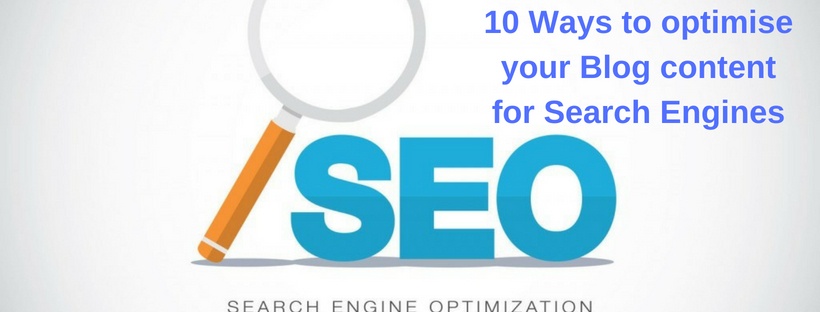
Blogging is one of the most cost-effective marketing investments you can make for your business. It’s an extraordinarily valuable tool for you to engage with customers and ultimately make their lives easier which is what business is all about! Every single post you publish is a long-term asset that helps build brand awareness and promote your expertise, products and services.
If you already have a blog, chances are you understand the importance of business blogging. But do you understand the importance of optimising your blog posts to make them easier to find in search engines?
FACT: By providing consistent, fresh and relevant content while at the same time performing some basic blogging optimisation strategies, you can hugely increase the opportunities associated with having your blog rank highly and having more customers reach your website!
Search engine optimisation is an incredibly important tool for businesses and helps to boost positioning of your website as a relevant answer to your customers questions. Google’s constantly changing algorithm updates can make this process a bit of a challenge, but as long as you have relevancy and intent top of mind, the following tips will be enough to get you started on optimising your blog and surging up to page one.
-
Table of Contents
Research
A no-brainer. It’s important to complete research into the keywords that can help optimise your blog. Chances are, you’re already naturally doing this simply by providing valuable content on a topic that’s relevant to your product or service. There are also a range of tools and techniques that can assist you in finding the right keywords to include in your posts. The Google Adwords Keyword Tool and offers great tools that allow you to find keywords related to your topic and even spy on your competition to see what words and phrases they are targeting to bring traffic to their sites.
-
Keywords
Now that you’ve researched which are the best keywords to be using, it’s important to place them where they will have the most impact and return the best result. You should be using them throughout your blogpost including:
- Title
- Headings and subheadings
- First sentence
- Last sentence
- Anchor text
- Title tags and meta descriptions
*Note to self: Don’t partake in keyword stuffing, not only will it be off-putting to your readers, it will be penalised by Google.
-
Long Tail Keywords
You should also be optimising your blog posts for keywords that match the intent of your ideal reader. A good rule of thumb is to focus on one or two long-tail keywords per blog post. These longer, often question-based keywords keep your post focused on the specific goals of your audience. Website visitors searching long-tail terms are more likely to read the whole post and then seek more information from you. In other words, you’ll generate the right type of traffic: visitors who convert.
-
Optimize images
Whenever you’re adding a photograph to your post, you should also be including keywords in the file name and the alt text field with a brief, keyword rich description.
-
Link to other sites as well as your own content
Good blogging etiquette dictates that you should be mentioning other relevant websites or resources (preferably not those of your competitors…). Not only is this generally useful information for your readers and followers, but hopefully you may receive some links in return! It’s also very valuable to link to other pages and content within your own site as well.
-
Have a subscribe option
Try to include a prominently placed RSS feed of subscribe button. This will not only be beneficial to your readers as it will give them an instant notification, but it helps Google to easily index your blog content through the feed.
-
Take advantage of social media
You can vastly broaden the reach of your blog posts while at the same time optimising for search engines just by posting on social media. As a business, you are likely already using these platforms so make sure you always share your content on your pages to get the most mileage out of them!
-
Make sure your blog is mobile friendly
Now more than ever, people are using their smartphones for absolutely everything! Google tends to display mobile-friendly results first. Websites that are responsive in design also allow blog pages to have just one URL as opposed to being split by a normal website and a separate mobile one. As a result, you can centralize the SEO power gained from putting effort into optimizing your blog.
-
Mix up your topic tags
Topic tags are very useful when it comes to organizing your blog content, but it can be harmful to overuse them. Having too many topic tags can be penalized by Google as duplicate content – without it actually being duplicate content.
-
Use Google’s Search Console
Google’s free Search Console contains a section called the Search Analytics Report. This report will help you to assess any clicks that have come from a Google Search and it’s an extraordinarily useful tool in determining which keywords people are using to find your blog content.
By following these ten simple tips, you’ll be able to encourage higher rankings and higher web traffic to your blog and website. Are you too busy to keep up with blog optimisation? Don’t worry – we can help get you a much more prominent position on search. Get in touch to find out more.
A 5-Step SEO Plan to maximize Your Search Engine Ratings
With the use of the internet in general, nowadays most of the business companies are shifting their business digitally. In order to run a digital business, you must introduce your business to the world and acquire top internet marketing services in Pakistan as one way of sharing your business is the Internet. Nowadays, Many companies have their websites online which provides services to their customers.
Your website must be designed according to an SEO expert in Pakistan for search engine visibility. Most of the people don’t know that SEO techniques are not just used for search engines but also serve as a marketing mix. The main focus of SEO services Pakistan is to drive traffic on your website. People look for what you offer. Here are 5 steps to maximize your SEO search engine ratings.
1:) Improve Your Page Loading Speed
The most important thing is Your page loading time for a few reasons. Because, if your load speed is too slow, Google will recognize this, and it will harm your ranking. But don’t forget that a slow website will also impact the way your website visitors engage with your pages. Which would result as those negative interactions will hurt your ranking too? You have to Look at how abandonment rates increase for websites with long page loading times.
2:) Produce High-Quality Content
How often do you update your website? If you have not touched it since the day you built it, you may don’t have a great SEO ranking right now. In order to drive more traffic to your website and increase its popularity, you need to give visitors a reason to keep coming back. Make sure Your content needs to be high quality, recent, and relevant. There is another factor that impacts your SEO ranking is so-called dwell time. This also relates to how much time people spend on your website per visit. Remember If your site has fresh, exciting, or newsworthy information, it will keep visitors on your page longer and improve your dwell time.
3:) Optimize Your Images
Images and other pictures are great for your website. But remember you need to make sure they are optimized properly if you want these images to improve your SEO ranking. I’m referring to factors such as the file format and size. Big images can slow your page loading time, which, as I’ve said, hurts your ranking. Resize or compress your images to optimize them.
4:) Break Your Content With Header Tags
Your content’s Headings are another way to help improve the user experience on your website. They break up the content and make it easier to read or skim. also, headers make everything look more appealing, which is always beneficial. If your Text of website is just a wall, it’s going to discourage people from spending a long time on it. As a result, your SEO ranking will suffer.
5:) Add More Than Text
Always remember The content on your website shouldn’t be only written words. As I said earlier, pictures are great too, but there’s more you can add to improve your SEO ranking. You can also Consider adding other multimedia elements such as videos, slideshows, or audio to your site. All of this can help improve the user experience.





